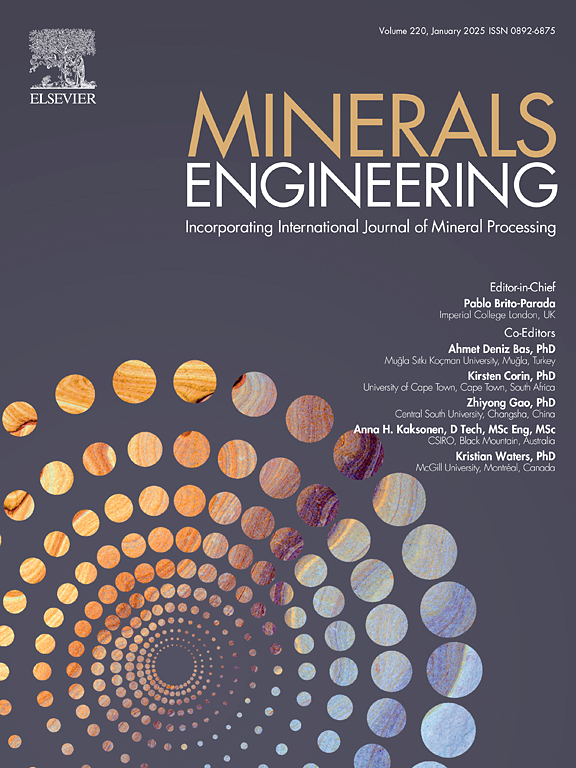刚果(金)Tenke-Fungurume沉积矿床铜钴矿区的地质冶金学
IF 4.9
2区 工程技术
Q1 ENGINEERING, CHEMICAL
引用次数: 0
摘要
本文介绍并分析了 Tenke-Fungurume 地区矿石的地质冶金学,该地区是全球铜和钴的主要产地。深部矿石主要是铜矿、铜铁矿和铜钴硫化物(黄铜矿组、黄铜矿、辉铜矿、褐铁矿、黄铁矿),赋存于不同硅化程度的白云岩和页岩层中。在距地表约 200 米的范围内,硫化物被孔雀石、杂玄武岩、锦辉石、假孔雀石和绿帘石所覆盖。在中间深度的混合区,除了硫化物和氧化物外,还含有钴白云石、辉绿岩、铜绿岩和原生铜等金属元素。各单元的平均破碎机功指数从 6.3 到 8.6 千瓦时/吨不等。平均碾磨功指数从基底砾岩的 10.8 千瓦时/吨到上覆不同硅化程度的白云质页岩的 15.4 千瓦时/吨不等。在这些白云质页岩中,两个功指数都与岩石单轴抗压强度密切相关。无层状硅化海泡石中也存在同样的相关性,其中的磨损指数也与石英含量相关。浮选试验显示,硫化物阶段的平均回收率为 87% 的铜和 61% 的钴,氧化物阶段的平均回收率为 61% 的铜和 40% 的钴。回收率最高的是硅化程度不同的白云质页岩,最低的是富含植物硅酸盐的基底单元。浮选过程中损失的主要是氧化物矿物和一些绿帘石。除了钴白云石的排斥之外,大多数浮选问题都是由于黝帘石、斜长石和绿泥石造成的,这些矿物会浓缩,并可能造成黏结和其他损失。以氧化物为主的矿石的可浸出率一般为 80-90%,除方解石外,原生硫化物的铜回收率为 20%。在浸出测试中,相同样品中的钴回收率超过铜回收率,但由于锁孔较多,且少量钴存在于不溶性绿泥石中,因此最终的钴回收率实际上较低。酸消耗量与白云石浓度有关,在轻微白云质页岩中最低为 226 千克/吨,在层状白云石中最高为 435 千克/吨。在测试的时间范围内,无法检测到其他煤矸石矿物的酸消耗。矿石在矿场被分为六种类型:无菌矿石、浸出矿石、氧化物矿石、硫化物矿石、氧化物为主的混合矿石和硫化物为主的混合矿石。前两种矿石的品位低于边界品位,几乎不含铜、钴矿物。根据快速浸出测试和 1 小时酸溶性铜分析的结果以及记录的矿物学,较高品位的材料被细分为后四类。总体而言,对地质冶金行为的主要控制是:(1)地表以下的深度,它影响品位并决定矿石矿物类型和浸出性;(2)岩石类型,它影响粉碎和浮选特性以及酸消耗量。许多研究结果突出表明,地质冶金特征描述需要包括尽可能多的纹理和地质信息,以帮助将地质特征与冶金结果联系起来。本文章由计算机程序翻译,如有差异,请以英文原文为准。
Geometallurgy of the Tenke-Fungurume sediment-hosted copper-cobalt district, D.R. Congo
This paper presents and analyzes the geometallurgy of ores at the Tenke-Fungurume district, a major global source of Cu and Co. Ores at depth are mainly Cu, Cu-Fe, and Cu-Co sulfides (chalcocite group, chalcopyrite, bornite, carrollite, pyrite) hosted in variably silicified dolomite and shale layers. Within roughly 200 m of the surface the sulfides are overprinted by malachite, heterogenite, brochantite, pseudomalachite, and chrysocolla. A mixed zone at intermediate depth contains metals as cobaltoan dolomite, sphaerocobaltite, cuprite, and native copper in addition to sulfides and oxides (sensu lato).
Geometallurgical properties are highly variable and anisotropic due to the wide unit-to-unit variation in lithology and alteration. Average crusher work index varies from 6.3 to 8.6 kWh/t across units. Average grinding Bond work index ranges from 10.8 kWh/t in the basal argillaceous conglomerate to 15.4 kWh/t in the overlying, variably silicified dolomitic shales. In these dolomitic shales, both work indices correlate strongly with rock uniaxial compressive strength. The same correlation is present in an unlaminated silicified algal dolomite, in which abrasion index also correlates with quartz content. There are no other observed correlations among comminution characteristics, geomechanical properties, and mineralogy.
Flotation tests show average recoveries of 87% Cu and 61% Co in the sulfide stage, 61% Cu and 40% Co in the oxide stage. Highest recoveries came from the variably silicified dolomitic shales, the lowest from the extremely phyllosilicate-rich basal unit. The main losses in flotation are of oxide minerals and some chalcocite. Apart from the rejection of cobaltoan dolomite, most flotation problems are due to muscovite, biotite, and chlorite, which report to concentrate and may cause sliming and other sources of loss.
Leach test recoveries for Cu and Co show strong inverse correlations with the fraction of metal hosted in sulfides. Oxide-dominated ores are generally 80–90 % leachable, with Cu recoveries < 20 % for primary sulfides other than chalcocite. In leach testing, Co recoveries exceed Cu recoveries in the same samples, though ultimate Co recovery in practice is lower due to more locking and minor Co hosted in insoluble chlorites. Acid consumption is a function of dolomite concentration and varies from a low of 226 kg/t in a slightly dolomitic shale to a high of 435 kg/t in a laminated dolomite. Acid consumption by other gangue minerals is undetectable over the timescale of testing.
Ores are divided into one of six types at the mine: sterile; leached; oxide; sulfide; oxide-dominant mixed; and sulfide-dominant mixed ores. The first two of these are below cutoff grade and contain few or no Cu or Co minerals. Higher-grade material is subdivided into the last four categories based on results from quick-leach testing and 1-hour acid-soluble Cu analysis, along with logged mineralogy. Overall, the main controls on geometallurgical behavior are (1) depth below surface, which influences grade and determines ore mineral type and leachability, and (2) rock type, which affects comminution and flotation characteristics and acid consumption. Many of the results highlight the need for geometallurgical characterization to include as much textural and geological information as possible to aid in correlating geological features with metallurgical outcomes.
求助全文
通过发布文献求助,成功后即可免费获取论文全文。
去求助
来源期刊

Minerals Engineering
工程技术-工程:化工
CiteScore
8.70
自引率
18.80%
发文量
519
审稿时长
81 days
期刊介绍:
The purpose of the journal is to provide for the rapid publication of topical papers featuring the latest developments in the allied fields of mineral processing and extractive metallurgy. Its wide ranging coverage of research and practical (operating) topics includes physical separation methods, such as comminution, flotation concentration and dewatering, chemical methods such as bio-, hydro-, and electro-metallurgy, analytical techniques, process control, simulation and instrumentation, and mineralogical aspects of processing. Environmental issues, particularly those pertaining to sustainable development, will also be strongly covered.
 求助内容:
求助内容: 应助结果提醒方式:
应助结果提醒方式:


